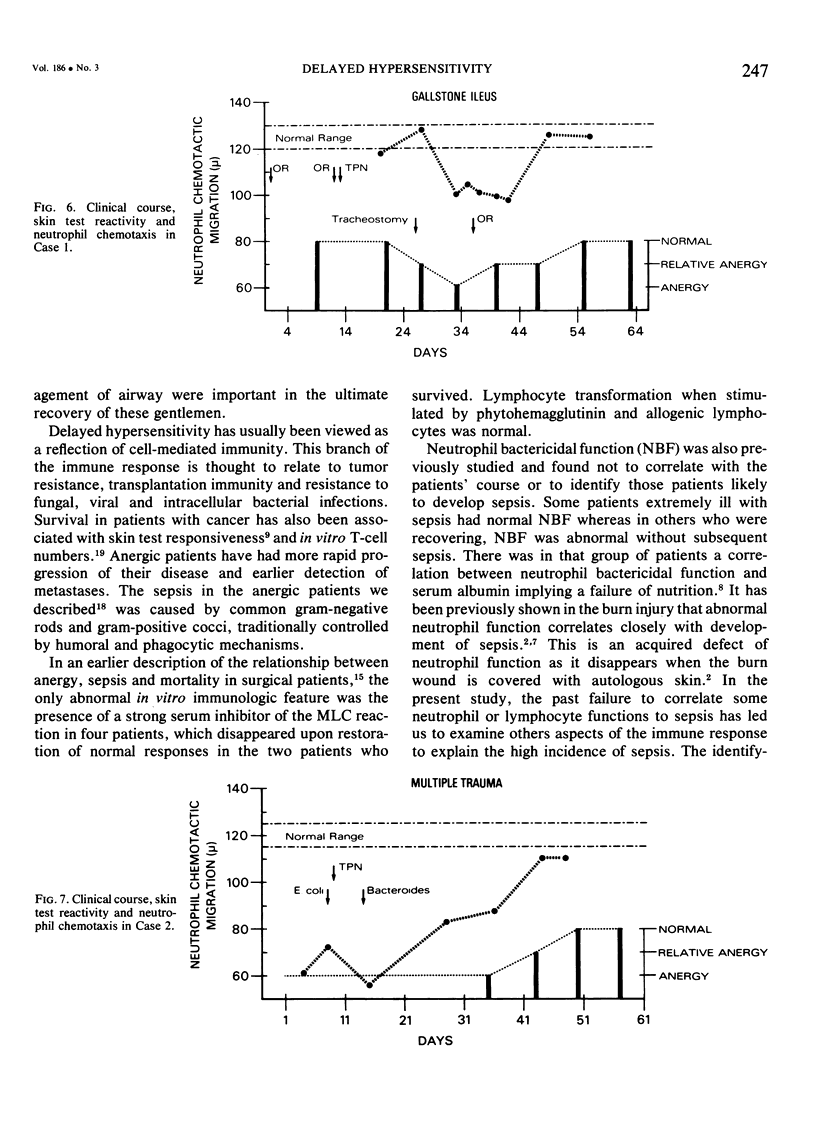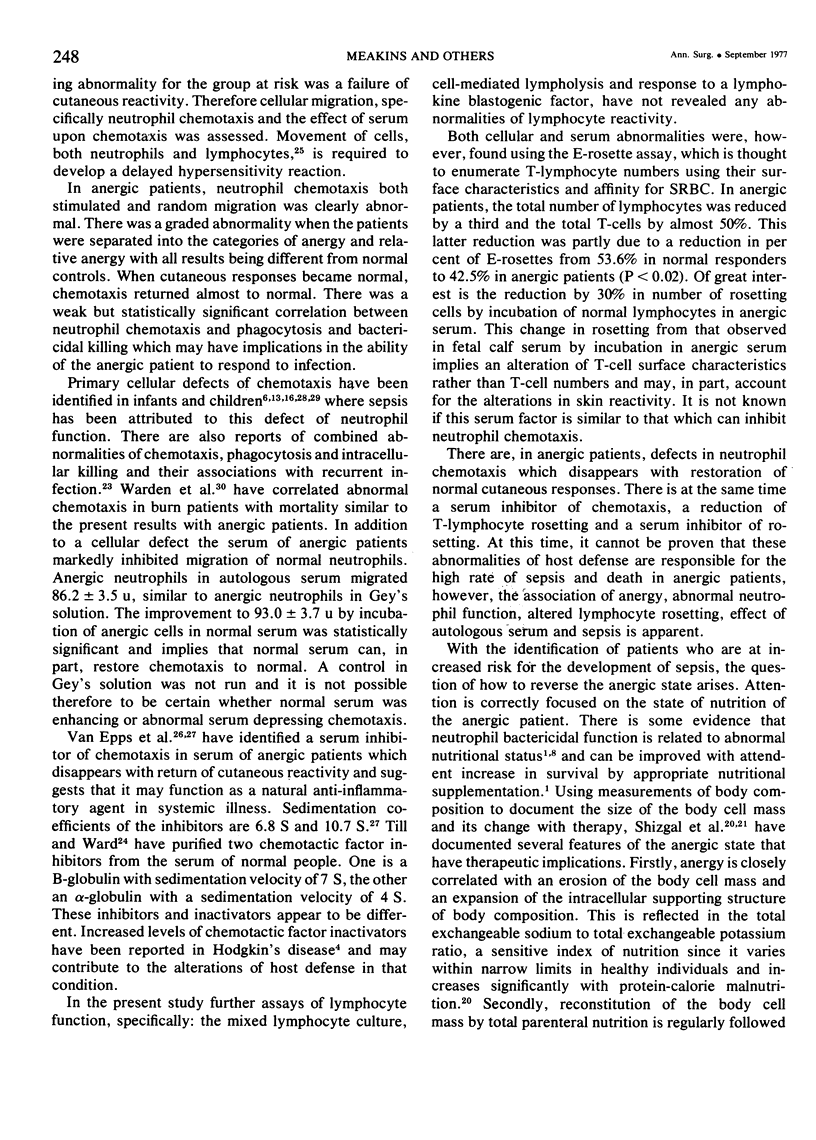Abstract
Primary failure of host defense mechanisms has been associated with increased infection and mortality. Anergy, the failure of delayed hypersensitivity response, has been shown to identify surgical patients at increased risk for sepsis and related mortality. The anergic and relatively anergic patients whose skin tests failed to improve had a mortality rate of 74.4%, whereas those who improved their responses had a mortality rate of 5.1% (P < 0.001). This study documents abnormalities of neutrophil chemotaxis, T-lymphocyte rosetting in anergic patients and the effect of autologous serum. These abnormalities may account for the increased infection and mortality rates in anergic patients. Skin testing with five standard antigens has identified 110 anergic (A) or relatively anergic (RA) patients in whom neutrophil chemotaxis (CTX) and bactericidal function (NBF), T-lymphocyte rosettes, mixed lymphocyte culture (MLC), cell-mediated lympholysis (CML), and blastogenic factor (BF) were studied. The MLC, CML and BF were normal in the patients studied, and were not clinically helpful. Neutrophil CTX in 19 controls was 117.5 ± 1.6 u whereas in 40 A patients, neutrophils migrated 81.7 ± 2.3 u and in 15 RA patients 97.2 ± 3.8 u (P < 0.01). In 14 patients whose skin tests converted to normal, neutrophil migration improved from 78.2 ± 5.4 u to 107.2 ± 4.0 u (P < 0.01). Incubation of A or control neutrophils in A serum reduced migration in A patients from 93 ± 3.7 u to 86.2 ± 3.5 u (P < 0.01) and in normals from 121.2 ± 1.6 u to 103.6 ± 2.6 u (P < 0.001). The per cent rosette forming cells in 66 A patients was 42.5 ± 3.1 compared to 53.6 ± 2.8 in normal responders (P < 0.02). Incubation of normal lymphocytes in anergic serum further reduced rosetting by 30%. Restoration of delayed hypersensitivity responses and concurrent improvement in cellular and serum components of host defense were correlated with maintenance of adequate nutrition and aggressive surgical drainage.
Full text
PDF








Selected References
These references are in PubMed. This may not be the complete list of references from this article.
- Alexander J. W. Emerging concepts in the control of surgical infections. Surgery. 1974 Jun;75(6):934–946. [PubMed] [Google Scholar]
- Alexander J. W., Meakins J. L. A physiological basis for the development of opportunistic infections in man. Ann Surg. 1972 Sep;176(3):273–287. doi: 10.1097/00000658-197209000-00003. [DOI] [PMC free article] [PubMed] [Google Scholar]
- Alexander J. W., Windhorst D. B., Good R. A. Improved tests for the evaluation of neutrophil function in human disease. J Lab Clin Med. 1968 Jul;72(1):136–148. [PubMed] [Google Scholar]
- BOYDEN S. The chemotactic effect of mixtures of antibody and antigen on polymorphonuclear leucocytes. J Exp Med. 1962 Mar 1;115:453–466. doi: 10.1084/jem.115.3.453. [DOI] [PMC free article] [PubMed] [Google Scholar]
- Berenberg J. L., Ward P. A. Chemotactic factor inactivator in normal human serum. J Clin Invest. 1973 May;52(5):1200–1206. doi: 10.1172/JCI107287. [DOI] [PMC free article] [PubMed] [Google Scholar]
- Clark R. A., Kimball H. R. Defective granulocyte chemotaxis in the Chediak-Higashi syndrome. J Clin Invest. 1971 Dec;50(12):2645–2652. doi: 10.1172/JCI106765. [DOI] [PMC free article] [PubMed] [Google Scholar]
- Curreri P. W., Heck E. L., Browne L., Baxter C. R. Stimulated nitroblue tetrazolium test to assess neutrophil antibacterial function: prediction of wound sepsis in burned patients. Surgery. 1973 Jul;74(1):6–13. [PubMed] [Google Scholar]
- Dhillon K. S., MacLean L. D., Meakins J. L. Neutrophil function in surgical patients: correlation of neutrophil bactericidal function, serum albumin, and sepsis. Surg Forum. 1975;26:27–28. [PubMed] [Google Scholar]
- Eilber F. R., Morton D. L. Impaired immunologic reactivity and recurrence following cancer surgery. Cancer. 1970 Feb;25(2):362–367. doi: 10.1002/1097-0142(197002)25:2<362::aid-cncr2820250213>3.0.co;2-v. [DOI] [PubMed] [Google Scholar]
- Gordon J., MacLean L. D. A lymphocyte-stimulating factor produced in vitro. Nature. 1965 Nov 20;208(5012):795–796. doi: 10.1038/208795a0. [DOI] [PubMed] [Google Scholar]
- Hartzman R. J., Segall M., Bach M. L., Bach F. H. Histocompatibility matching. VI. Miniaturization of the mixed leukocyte culture test: a preliminary report. Transplantation. 1971 Mar;11(3):268–273. doi: 10.1097/00007890-197103000-00005. [DOI] [PubMed] [Google Scholar]
- Hill H. R., Quie P. G. Raised serum-IgE levels and defective neutrophil chemotaxis in three children with eczema and recurrent bacterial infections. Lancet. 1974 Feb 9;1(7850):183–187. doi: 10.1016/s0140-6736(74)92493-3. [DOI] [PubMed] [Google Scholar]
- Jondal M., Holm G., Wigzell H. Surface markers on human T and B lymphocytes. I. A large population of lymphocytes forming nonimmune rosettes with sheep red blood cells. J Exp Med. 1972 Aug 1;136(2):207–215. doi: 10.1084/jem.136.2.207. [DOI] [PMC free article] [PubMed] [Google Scholar]
- MacLean L. D., Meakins J. L., Taguchi K., Duignan J. P., Dhillon K. S., Gordon J. Host resistance in sepsis and trauma. Ann Surg. 1975 Sep;182(3):207–217. doi: 10.1097/00000658-197509000-00004. [DOI] [PMC free article] [PubMed] [Google Scholar]
- Osoba D., Falk J. The mixed-leukocyte reaction in man: effect of pools of stimulating cells selected on the basis of crossreacting HL-A specificities. Cell Immunol. 1974 Jan;10(1):117–135. doi: 10.1016/0008-8749(74)90156-7. [DOI] [PubMed] [Google Scholar]
- Shizgal H. M., Spanier A. H., Kurtz R. S. Effect of parenteral nutrition on body composition in the critically ill patient. Am J Surg. 1976 Feb;131(2):156–161. doi: 10.1016/0002-9610(76)90089-1. [DOI] [PubMed] [Google Scholar]
- Spanier A. H., Pietsch J. B., Meakins J. L., MacLean L. D., Shizgal H. M. The relationship between immune competence and nutrition. Surg Forum. 1976;27(62):332–336. [PubMed] [Google Scholar]
- Tan J. S., Strauss R. G., Akabutu J., Kauffman C. A., Mauer A. M., Phair J. P. Persistent neutrophil dysfunction in an adult. Combined defect in chemotaxis, phagocytosis and intracellular killing. Am J Med. 1974 Aug;57(2):251–258. doi: 10.1016/0002-9343(74)90449-5. [DOI] [PubMed] [Google Scholar]
- Tan J. S., Watanakunakorn C., Phair J. P. A modified assay of neutrophil function: use of lysostaphin to differentiate defective phagocytosis from impaired intracellular killing. J Lab Clin Med. 1971 Aug;78(2):316–322. [PubMed] [Google Scholar]
- Till G., Ward P. A. Two distinct chemotactic factor inactivators in human serum. J Immunol. 1975 Feb;114(2 Pt 2):843–847. [PubMed] [Google Scholar]
- Uhr J. W. Delayed hypersensitivity. Physiol Rev. 1966 Jul;46(3):359–419. doi: 10.1152/physrev.1966.46.3.359. [DOI] [PubMed] [Google Scholar]
- Van Epps D. E., Frierson J. A., Williams R. C. Immunological studies of anergic patients. Infect Immun. 1974 Nov;10(5):1003–1009. doi: 10.1128/iai.10.5.1003-1009.1974. [DOI] [PMC free article] [PubMed] [Google Scholar]
- Van Epps D. E., Palmer D. L., Williams R. C., Jr Characterization of serum inhibitors of neutrophil chemotaxis associated with anergy. J Immunol. 1974 Jul;113(1):189–200. [PubMed] [Google Scholar]
- Ward P. A. Leukotaxis and leukotactic disorders. A review. Am J Pathol. 1974 Dec;77(3):520–538. [PMC free article] [PubMed] [Google Scholar]
- Ward P. A., Schlegel R. J. Impaired leucotactic responsiveness in a child with recurrent infections. Lancet. 1969 Aug 16;2(7616):344–347. doi: 10.1016/s0140-6736(69)92699-3. [DOI] [PubMed] [Google Scholar]
- Warden G. D., Mason A. D., Jr, Pruitt B. A., Jr Suppression of leukocyte chemotaxis in vitro by chemotherapeutic agents used in the management of thermal injuries. Ann Surg. 1975 Mar;181(3):363–369. doi: 10.1097/00000658-197503000-00019. [DOI] [PMC free article] [PubMed] [Google Scholar]
- Zigmond S. H., Hirsch J. G. Leukocyte locomotion and chemotaxis. New methods for evaluation, and demonstration of a cell-derived chemotactic factor. J Exp Med. 1973 Feb 1;137(2):387–410. doi: 10.1084/jem.137.2.387. [DOI] [PMC free article] [PubMed] [Google Scholar]


